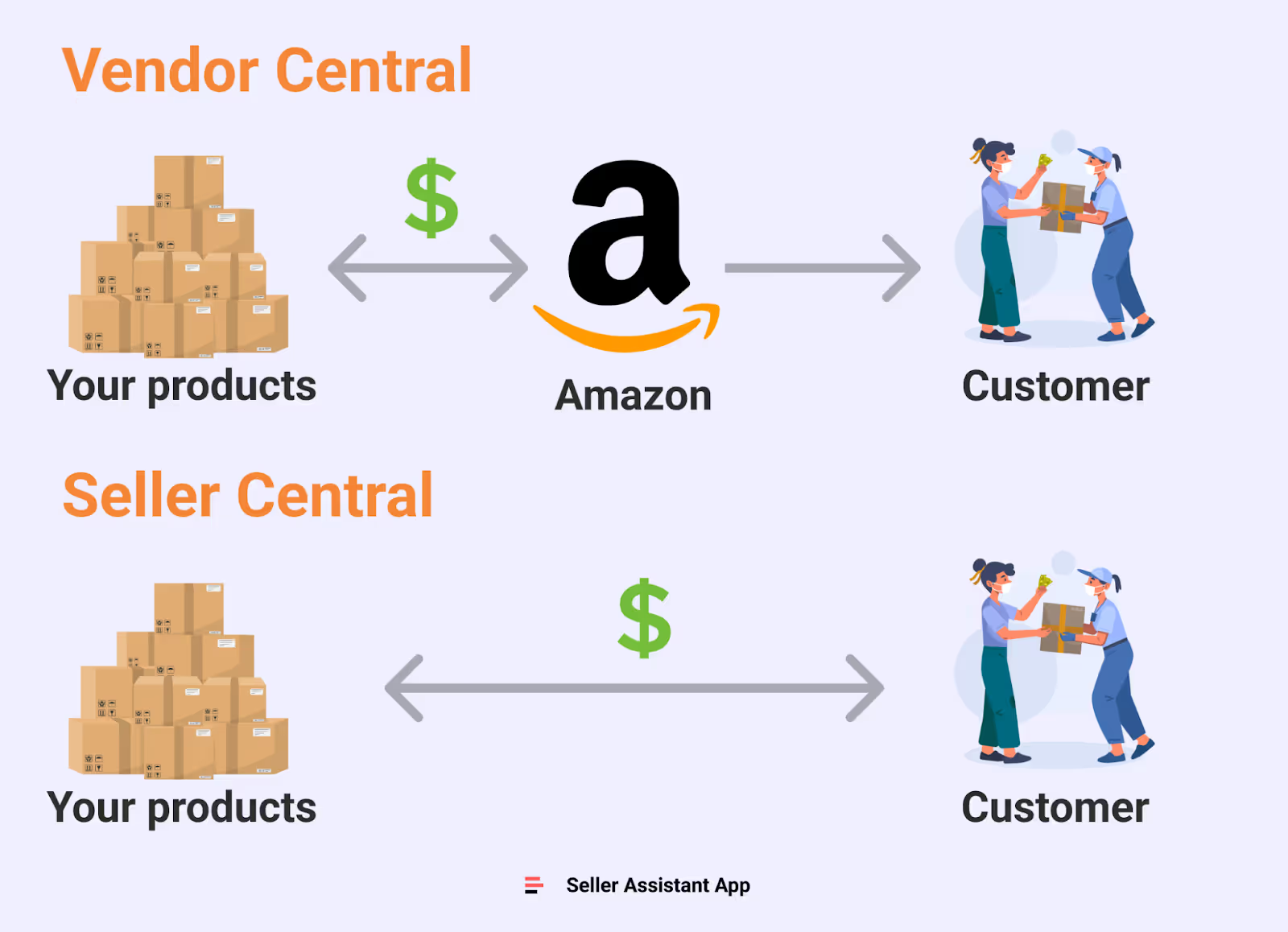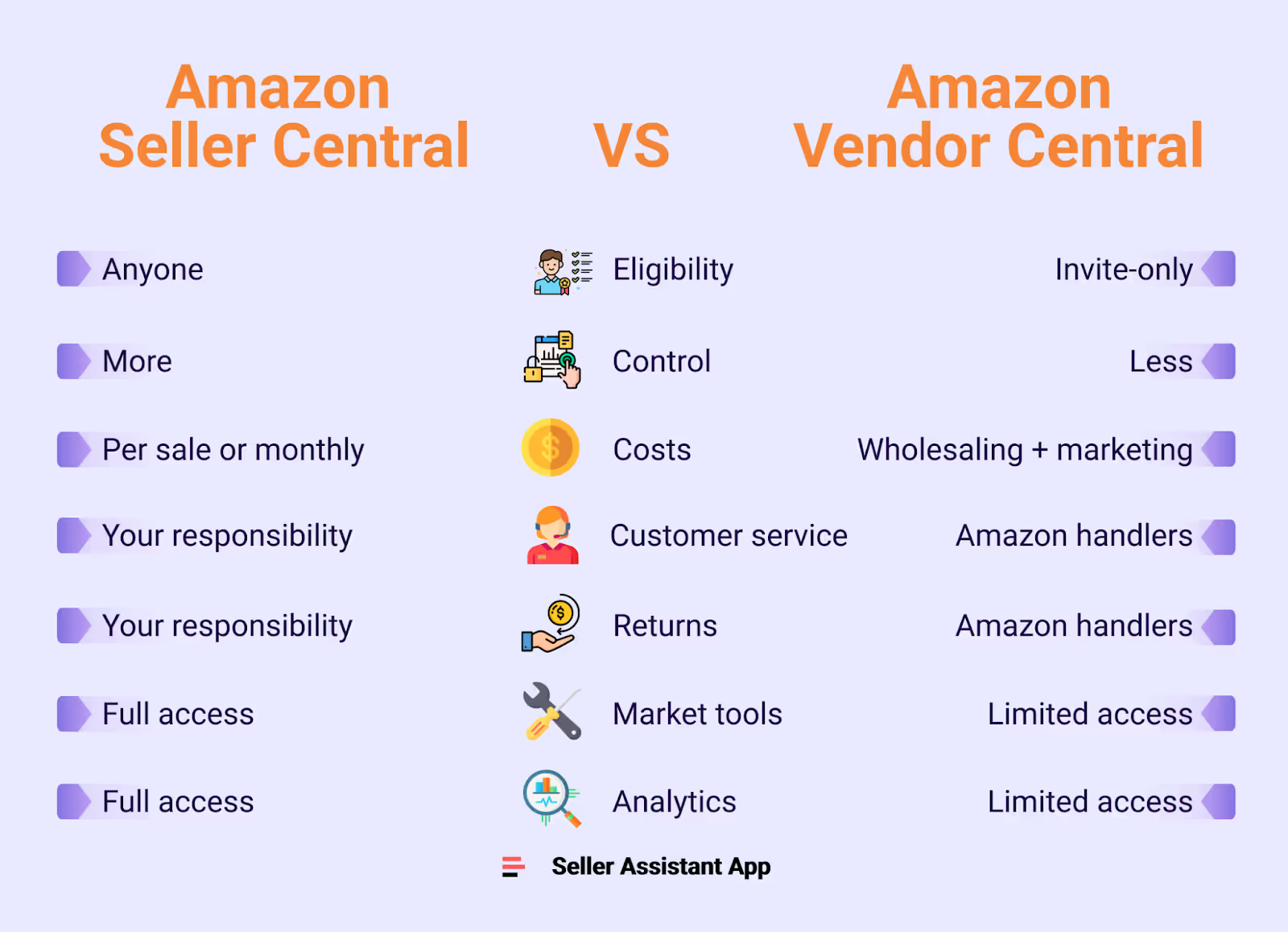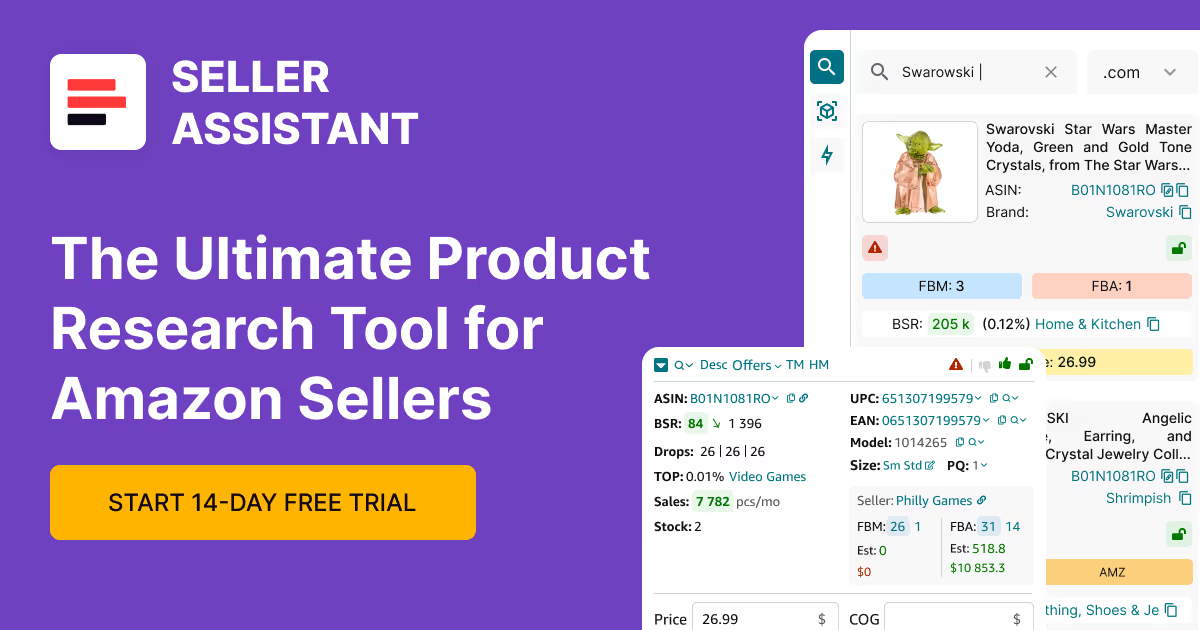Amazon Seller Central vs. Vendor Central — All You Need To Know
Download Amazon Seller Guide
This guide will help you get started, understand the basics of Amazon selling, and explain in simple words how it all works.

As an Amazon seller, you've probably heard of Amazon Seller Central and Amazon Vendor Central. If so, you probably wonder what are the differences between the two platforms and which one is right for you.
The answer depends on your business scope and goals. With Vendor Central, Amazon buys from you and resells to its customers. With Seller Central, you sell to customers directly using the Amazon marketplace.
In this post, we'll take a closer look at Amazon Seller Central and Amazon Vendor Central and help you decide which platform best fits your business.

Related: Seller Assistant App Extension Review
Seller Assistant App — the Ultimate Tool for Amazon Online Arbitrage
What Is Amazon Seller Central?
Amazon Seller Central is a web-based platform that allows businesses to sell their products on Amazon. It's a one-stop shop for effectively managing sales and your go-to resource for selling in Amazon's store.
With Amazon Seller Central, you can:
- Create and manage product listings;
- Set prices and inventory levels;
- Track sales and orders;
- Communicate with customers;
- Use Amazon's marketing tools and analytics;
- Manage your seller account.
Amazon Seller Central is open to anyone who wants to sell products on Amazon. Sellers can have two types of accounts on Seller Central: Amazon individual account and a professional account.
Individual sellers pay a per-item fee of $0.99 for each product they sell, while professional sellers pay a monthly subscription fee of $39.99. If you sell more than 40 items per month, it is more cost-effective to have a professional account.
Related: How to Sell on Amazon for Beginners - Complete Guide
How to Sell on Amazon as an Individual Seller — Complete Guide
What Is Amazon Vendor Central?
Amazon Vendor Central is a web-based platform that allows manufacturers and distributors to sell their products to Amazon. It is an invite-only platform designed for large businesses with an extensive product catalog.
With Amazon Vendor Central, you can:
- Create and manage product listings;
- Receive purchase orders from Amazon and provide shipment information.
- Set prices and inventory levels;
- Track sales and orders;
- Communicate with Amazon;
- Market products by using features like Amazon Vine, A+ Content, and Advertising Console;
- Use Amazon reporting;
- Manage your vendor account.
Suppose you are a manufacturer or distributor with a large product catalog. In that case, Amazon Vendor Central can be a great way to sell your products to Amazon and reach a wider audience of potential buyers.
Note. As a seller, you can sell both via Amazon Vendor Central and Amazon Seller Central. With this combined approach, you can sell some of your products to Amazon as a first-party seller (vendor) and other products as a third-party seller.
Related: How to List Products on Amazon - Complete Guide
How to Create an Amazon Best Product Description that Ranks High in Search
Difference between Seller Central and Vendor Central
Amazon Seller Central and Amazon Vendor Central are two platforms that allow businesses to sell their products on Amazon. However, there are some key differences between the two platforms. Below you can find a summary of the key differences between Amazon Seller Central and Amazon Vendor Central.
Product Sales
Seller Central: You sell your products directly to Amazon customers.
Vendor Central: You sell your products to Amazon, which then sells them to their customers.
Eligibility
Seller Central: Anyone can register.
Vendor Central: Amazon invites you to become a vendor.
Relationship with Amazon
Seller Central: You have a limited relationship with Amazon. You are responsible for managing your inventory, pricing, and customer service.
Vendor Central: You have a direct relationship with Amazon. Amazon handles inventory management, pricing, and customer service.
Control
Seller Central: You have more control over your products, pricing, inventory, and shipping.
Vendor Central: You have less control. Amazon has pricing control of your product as it goes on its platform.
Fees
Seller Central: You pay referral fees on top of the selling fees per sale or a monthly fee of $39.99.
Vendor Central: You pay 4% – 10% to cover slotting and marketing fees. There might also be unexpected additional costs you have to pay.
Reporting
Seller Central: You have more detailed consumer data and reporting options.
Vendor Central: You only have basic sales and inventory data.
Logistics
Seller Central: You have control over the logistics, or you can hand the job to FBA.
Vendor Central: You must follow Amazon's strict regulations and logistic requirements.
Returns and communications
Seller Central: You are responsible for messaging your customers and following up on their returns.
Vendor Central: Amazon does all of it for you.
Related: How to Create an Amazon Seller Central Account
Amazon Account Health: A Guide for FBA Sellers

Pros and Cons of Seller Central
Seller Central is a great platform for businesses of all sizes to sell their products on Amazon. However, it's important to be aware of its advantages and disadvantages before you start selling on Amazon.
Seller Central pros
Low barrier to entry
Anyone can sign up for Seller Central, so you don't need a significant upfront investment to get started.
Flexibility
You have a lot of control over your products, pricing, inventory, and shipping.
Marketing tools and analytics
Amazon offers a variety of marketing tools that help reach more customers and detailed analytics to track your performance and make informed decisions about your business.
Seller Central cons
Competition
Amazon is a very competitive marketplace, so you'll need to price your products competitively and offer excellent customer service in order to succeed.
Fees
You'll need to pay various fees to sell on Amazon, including referral fees and variable closing or monthly fees. If you use Fulfillment by Amazon, you will pay more.
Customer service
You're responsible for handling customer service for your products. That can be time-consuming and challenging, especially if you have a large volume of orders. You can have Amazon handle customer service for you with FBA, but the service involves costly fees.
Related: What is Amazon Seller Account Health Rating?
Amazon Business Models: How to Choose the Right One?
Pros and Cons of Vendor Central
Vendor Central can be an excellent option for businesses that want to sell their products on Amazon without having to worry about complicated sales procedures. However, it's essential to know the upsides and downsides of being a Vendor Central vendor.
Vendor Central pros
Less competition
Vendor Central is an invite-only program, so there is less competition than on Seller Central. That can give you an advantage in terms of visibility and sales.
Amazon handles everything
Amazon handles all aspects of the selling process, including sales, pricing, and customer service. That can free up your time and resources to focus on product development and manufacturing.
Access to Amazon's marketing tools
Amazon Vendor Central gives you access to Amazon's marketing tools, which can help you promote your brands and reach more customers.
Vendor Central cons
Less control
You have less control over your products, pricing, and inventory on Vendor Central than Seller Central. Amazon makes the final decisions on these matters. That can reduce per-item profits.
Rigid logistics requirements
Amazon has strict requirements for vendors to follow when filling purchase orders. Vendors that have problems maintaining their stock or fulfilling orders may quickly experience chargebacks, which can reduce their profits.
Longer sales cycle
The sales cycle on Vendor Central can be longer than on Seller Central, as Amazon needs to approve your products and inventory before they can be listed for sale. Also, payment terms are longer than in Seller Central (once a month vs. once in 14 days).
Which Is the Best for You — Seller Central or Vendor Central?
The choice between Seller Central and Vendor Central depends on your specific business needs and goals. By carefully considering the pros and cons of each platform, you can make a wise decision that will help you succeed on Amazon.
If you are a small business with limited resources, Amazon Seller Central may be a better option. You will have more control over your product listings and pricing, and you can use Amazon's marketing tools to reach a wider audience. However, you will also be responsible for handling sales and returns.
Amazon Vendor Central may be a better option if you are a large manufacturer or distributor with an extensive product catalog. You will have less control over your product listings and pricing, but Amazon will handle all aspects of the complicated sales process. That can free up your time and resources to focus on product development and manufacturing.
Related: Amazon Glossary for Sellers
13 Rules of OA Product Research Tested by Pain and Gain of Amazon Seller
FAQ
What is the difference between Amazon Vendor Central and Amazon Seller Central?
Amazon Vendor Central is an invite-only program where businesses sell their products to Amazon. Amazon then takes care of the entire selling process. Amazon Seller Central is a platform where businesses of all sizes sell products to end customers and use Amazon as a marketplace.
What is Amazon Vendor Central?
Amazon Vendor Central is an invite-only program where businesses sell their products to Amazon. Amazon then takes care of the entire selling process, including inventory management, pricing, and customer service. Businesses that use Amazon Vendor Central are essentially wholesalers.
Is FBA Vendor Central or Seller Central?
If you use Vendor Central, Amazon handles all shipping for vendors. Vendors ship their products to Amazon's warehouses, and Amazon takes care of the rest. If you use Seller Central, you can either ship your products yourself or use Fulfillment by Amazon (FBA), where Amazon picks, packs, and ships your products.
Can you have Vendor Central and Seller Central?
Yes, you can sell different Amazon products through Vendor Central and Seller Central accounts. You can choose which products to sell under each account based on factors such as product type, target audience, desired level of control, and target profit margin.
How do I change from Amazon Vendor Central to Seller Central?
To change from Amazon Vendor Central to Seller Central, confirm with your Vendor Manager that you can shift from wholesaler to retailer. Then, create a Seller Central account, and mark your products in Vendor Central as “Permanently unavailable.”
Final Thoughts
To sum up, Amazon Seller Central and Vendor Central are two different platforms with their own advantages and disadvantages. The best platform for you will depend on your specific needs, goals, and business size. If you are a small business that wants more control over your products and pricing, Seller Central might be the right choice. However, suppose you are a large distributor or manufacturer who wants to simplify the sales process and take advantage of Amazon's logistical network and customer service. In that case, Vendor Central might be a better option.
Whichever platform you select, your success depends on choosing products to sell. Seller Assistant Аpp can effectively and reliably help you find the best products for Amazon arbitrage and dropshipping. This all-in-one extension shows you all product’s metrics and the profit you will get. It also helps you immediately see if a product has any sales restrictions or has previously triggered problems with account health. It combines an FBM&FBA profit calculator, Quick View, Stock Checker, and Restrictions Checker in one tool.

.svg)













